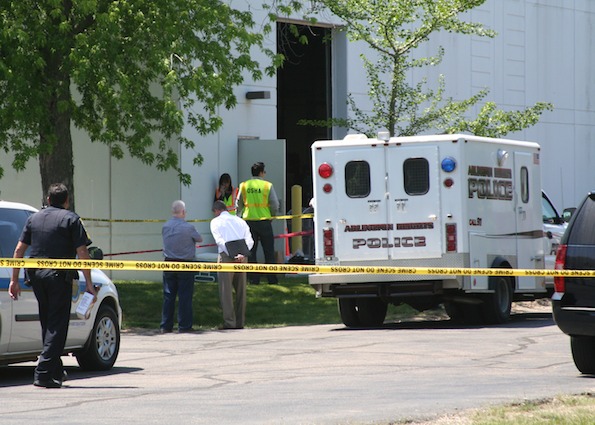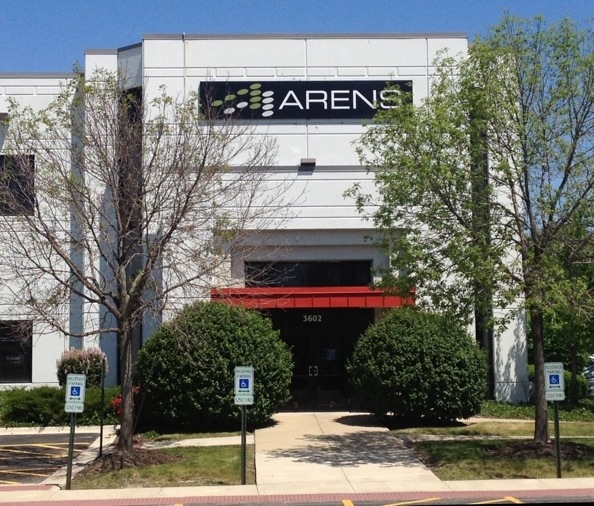VIDEO: Extra-alarm ambulance response at Arens Control plant after an explosion killed one employee, injured seven employees, and also injured three police officers.
Arlington Heights police and firefighter/paramedics responded about 8:38 a.m. Tuesday to a report of an explosion in a warehouse/factory building at 3602 N. Kennicott Ave. in Arlington Heights. Police officers from Arlington Heights and Buffalo Grove arrived first to help evacuate the building. Firefighters arrived to find the building being evacuated and some light smoke and twisted metal inside of the building.
One person, who has been identified as Arens employee Neil Nicholson, 55, was killed in some type of industrial accident and explosion — possibly involving potassium hydroxide.
The explosion also injured seven employees at the time of the blast, three police officers, and two firefighter/paramedics, who were first on the scene after the explosion. The employees suffered overpressure injuries from the blast and/or exposure to potassium hydroxide, which is a skin and respiratory irritant. The overpressure injuries related to the blast of the explosion were reported to involve hearing-related injuries and chest pain. The emergency responders were apparently exposed to fumes, gases or smoke in the aftermath of the explosion. Some personnel were experiencing coughing and headache. All people transported to Northwest Community Hospital were in good condition as of 11:30 a.m., according to Northwest Community Hospital.
Arlington Heights Fire Department activated an extra alarm for mutual aid ambulances from Buffalo Grove, Palatine, Prospect Heights, Wheeling and others fire departments.
All people that were transported seemed to be walking in good shape before they were transported by firefighter/paramedics to the hospital. Neil Nicholson’s body remained inside the building for part of the investigation, and was not immediately removed Tuesday.
A brief fire occurred, but was immediately extinguished before firefighters arrived.
In medical textbooks, blast injuries are categorized as four types:
(1) Primary injuries, which involve direct injuries to ears and internal organs from overpressure of air molecules hitting victims in a shock wave. The most common cause of fatalities that occur after initial survival of an explosion are injuries to the lungs, alveoli and pulmonary blood vessels. The resulting pulmonary contusion, bleeding or swelling is known as blast lung.
(2) Secondary injuries, which are cause by shrapnel, such as flying glass, flying metal or other flying objects can cause penetrating trauma with visible bleeding and possible severe blood loss.
(3) Tertiary injuries, which are caused by victims being thrown into something, can cause blunt and/or penetrating trauma, such as bone fractures and brain trauma caused by motion of the brain inside the skull. Brain trauma can occur when the head strikes an object and the momentum of the brain inside the skull causes the brain to collide with the inside of the skull.
(4) Quaternary injuries include flash burns, chemical splash, respiratory injuries, crush injuries, and all injuries not classified in the first three classes. Eye injuries, amputations, neurological damage and/or psychiatric injury that can cause post-traumatic stress disorder are included in the quaternary class.
Potassium hydroxide is a strong base chemical, also known as caustic potash. Potassium hydroxide in modern chemistry is produced by electrolysis of potassium chloride solutions. Hydrogen gas is formed as a byproduct on the cathode, which is an electrode that attracts positively charged atoms or molecules. Chlorine gas is formed as a byproduct on the anode, which is an electrode that attracts negatively charged atoms or molecules. The hydrogen ion is a positively charged ion. The chloride ion is a negatively charged ion. Hydrogen is highly explosive. Hydrogen gas forms explosive mixtures with air if it is 4–74% concentrated. Hydrogen forms explosive mixtures with chlorine if it is 5–95% concentrated. Mixtures spontaneously explode by spark, heat or sunlight.
Interestingly there was an odor of chlorine gas east of the scene — downwind from the building. A neighbor, who said he frequently walks past the building, said he never noticed the chlorine smell before.
It is unknown whether the company was producing potassium hydroxide or using it for some other application, such as producing hydrogen for some commercial vehicle energy application.
Potassium hydroxide itself is non-flammable — it’s the white stuff you see leaking from dead alkaline batteries that are left in a device too long. Potassium hydroxide (KOH) is rated 3 out of 4 as a health hazard by the NFPA 704 standard maintained by the National Fire Protection Association. KOH does not burn on its own — it’s rated 0 out of 4. KOH is reactive at high temperatures and pressures.
NFPA Fire Diamond* for Postassium Hydroxide explained …
BLUE (Health) = 3: Short-term exposure could cause serious temporary or moderate residual injury.
RED (Flammability) = 0: Will not burn [Hydrogen is a 4 — Rapidly or completely vaporizes at normal atmospheric pressure and temperature, or is readily dispersed in air and will burn readily (e.g., propane, hydrogen). Flash point below 23°C (73°F)].
YELLOW (Reactivity) = 1: Normally stable, but can become unstable at elevated temperatures and pressures.
WHITE (Special) = ALK: Alkaline.
* The NFPA Fire Diamond gives firefighters a quick general size-up of a hazardous material at a business. Firefighters also look for relevant Material Safety Data Sheets (MSDS) when they arrive on the scene in an emergency. Here is an example of the MSDS for Potassium Hydroxide made available from Iowa State University.
Potassium, by itself, is a raw alkali combustible metal, that oxidizes rapidly in air, and can react violently with water — generating enough heat to cause a fire. Small potassium combustible metal fires are extinguished in a laboratory with Class D fire extinguishers. Potassium metal is not to be confused with potassium hydroxide.
Potassium ions — sometimes simply called ‘potassium’ — are positive ions and vital electrolytes in human physiology that are important for nerve conduction, muscle contractions, and cardiac contractions (beating of the heart). The potassium ion is the main intracellular ion for all cells, and is also important for maintenance of fluid and electrolyte balance. Bananas, orange juice, avocados and apricots are some of many fruits that are a good source of ‘potassium’ or more accurately — potassium ions.
Police investigators, fire investigators, the Illinois State Fire Marshal and OSHA personnel were all on the scene by about 1:00 p.m. Tuesday. OSHA will likely present a detailed report of the cause of the accident with recommendations for preventing future industrial accidents, but the report could take about six months to be completed.
According to officials, no criminal activity is suspected related to the explosion, which is believed to be an industrial accident.
No visible damage was seen outside the building. Fire Chief Glenn Ericksen and police Capt. Ken Galinski reported that there was twisted metal inside related to the explosion. The roof was also slightly buckled in the explosion. Some gravel rock was blown off the roof of the building and damaged about 20 cars parked near the building.
Firefighters from Buffalo Grove inspected the roof by way of their ladder tower truck.
According to their official website, Arens is a world leader in engineering and manufacturing of precision operator interface control systems as well as power management systems for commercial vehicles — including the hybrid vehicle market. Arens reports their engineers are focused on developing innovative solutions and next generation technology control and power management systems for commercial vehicle manufacturers.

Photo OSHA on the scene: Most rescue and investigator activity was on the northeast corner of the Arens building, 3602 North Kennicott Avenue, Arlington Heights.

Entrance to Arens control, 3602 N. Kennicott Ave. at the southeast corner of the building.
Stay informed with news from The Cardinal’s Emergencies Behind the Scenes Facebook page — Facebook.com/CardinalEmergencies. Includes links to favorite public safety and emergency rescuers and product manufacturers and safety companies that have facebook pages. Submit your pictures or just stay up-to-date on with fire, rescue, EMS and police photo galleries. Please add your public safety photo to the wall album — go direct to the Arlington Cardinal Emergencies Behind the Scenes photos. For a list of all of The Cardinal Facebook fan pages, go to Arlingtoncardinal.com/about/facebook …


